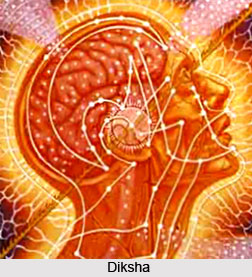 Diksha or the Initiation Ceremony is a way to grant all objects of desire. During the initiation ceremony the worshipper should adore Hari in the circle of a lotus. The worship of Hari during the ceremony involves a number of ceremonies which are to be followed by a worshipper in order to successfully complete the Initiation ceremony or the Diksha. It is advised that a worshipper should adore Lord Vishnu seated with his face directed towards the east. He should then adore Hari clad in raiment and adorned with five jewels, in the sacrificial altar offering oblations to fire in his honour and reciting mantrams for his adorations.
Diksha or the Initiation Ceremony is a way to grant all objects of desire. During the initiation ceremony the worshipper should adore Hari in the circle of a lotus. The worship of Hari during the ceremony involves a number of ceremonies which are to be followed by a worshipper in order to successfully complete the Initiation ceremony or the Diksha. It is advised that a worshipper should adore Lord Vishnu seated with his face directed towards the east. He should then adore Hari clad in raiment and adorned with five jewels, in the sacrificial altar offering oblations to fire in his honour and reciting mantrams for his adorations.
It is said that the votary should say to the lord that He is the refuge of the beasts, sunk in the ocean of the world. He is the one who always forgives the celestials and as a result the devotee releases all the beasts unto the lord. Having made this declaration to the Lord of the celestials the votary should allow the beasts to enter the temple. Then he should purify them and duly perform the rite of recitation and worship. The worshipper should also mention the name of the idol on which flowers fall.
Agni Purana narrates that the next step in the Diksha ceremony involves meditating on the Prakriti in whom the universe lies and from whom the universe is born and who appears as manifold by her various actions. Thereupon having meditated on all the Tattwas, beginning in order of creation from Prakriti to the earth the worshipper should assign them to the body of his disciple. Having drawn all the Tanmatras with self the worshipper should place the Maya rope on the body of the beast. It is believed that Prakriti is the creative power-the agent is the Buddhi or Manas.
In order to describe the Diksha ceremony the Purana has described all the steps in detail. It is mentioned that several Homas should be performed and the most perfect oblation should be offered to the lord. Then having duly performed the adhivasa ceremony he should initiate his devoted disciple. The worshipper should adore Hari and should perform a sacrifice in the honour of Vishnu in the altar. In the initiation ceremony the disciple is seated in Padmasana and the worshipper initiates his disciple in that particular posture.
Agni Purana states that the worshipper should subtract the Tattwas and should attain quietitude. He should then offer oblation to the fire. Afterwards with the help of the Jnana Yoga he should immerse Jiva, freed of worldly fetters in the Eternal Parmatman. It has been said that the learned man should think of the spirit of disassociation in the Ever blissful pure and intelligent Atman. Afterwards he should offer the Purna oblation in honour of the deity and complete the rite of Diksha or initiation.



















